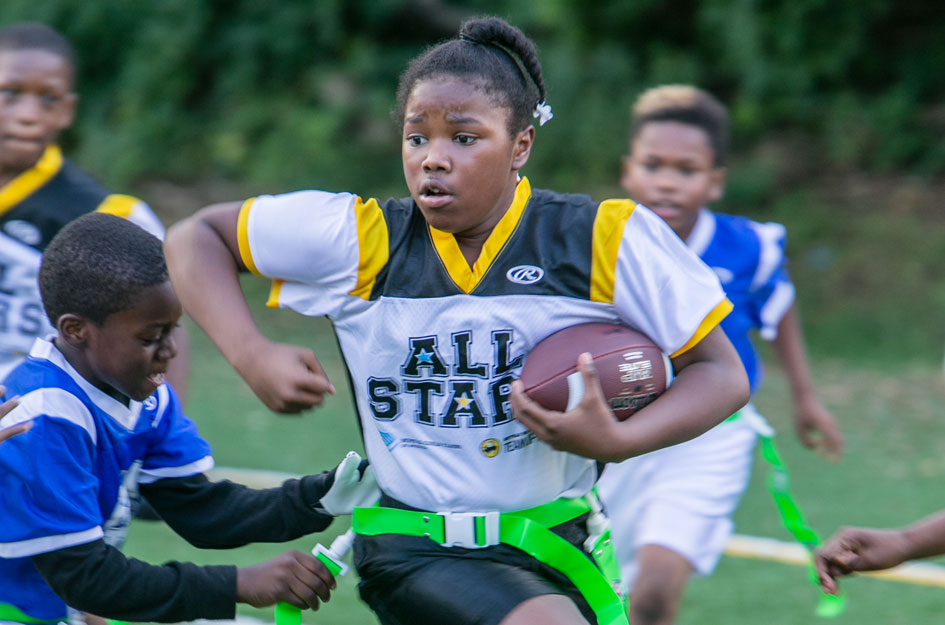According to the Women In Sports Foundation, girls around the age of 14 drop out of sports at a rate two times as fast as boys. The older they get, the less opportunities girls have to participate in organized sports. Girls only sports teams are a great way to get girls more active! They have the ability to remove some of the barriers girls have in participating in sports by creating a safe environment for them to have fun! Research shows that one of the most impactful strategies to increase physical activity in girls is to give them their own time, place and activities to play sports, away from the boys.
That’s why, for many years, Boys & Girls Club of Whitter has provided girls sports at three middle schools, with all-girls basketball and soccer, as well as a volleyball league that is dominated with girls’ teams. Last year, the Club greatly expanded its sports programming and in turn, greatly increased girls playing sports throughout community. Additionally, the Club started ten new girls’ teams at nine elementary schools plus the Main Clubhouse, offering two new girls sports leagues, basketball and soccer. Now in its second year, co-ed flag football teams have increased female participation to 30%.
With support from Buffalo Wild Wings and the ALLSTARS program, Clubs can continue to remove barriers girls face when participating in sports all in a safe, fun environment.
- Why they drop out: Lack of access. Girls have 1.3 million fewer opportunities to play high school sports than boys have. Lack of physical education in schools and limited opportunities to play sports in both high school and college mean girls have to look elsewhere for sports –which may not exist or may cost more money. Often there is an additional lack of access to adequate playing facilities near their homes that makes it more difficult for girls to engage in sports.
Why they need to stay in:
Through sports, girls learn important life skills such as teamwork, leadership and confidence.
- Why they drop out: Safety and transportation issues. Sports require a place to participate – and for many girls, especially in dense urban environments, that means traveling to facilities through unsafe neighborhoods or lacking any means to get to a good facility miles away. And if there isn’t a safe option like carpooling with other families, the only option for a girl and her family may be to stay home.
Why they need to stay in:
Girls active in sports during adolescence and young adulthood are 20% less likely to get breast cancer later in life.
- Why they drop out: Social stigma. Despite recent progress, discrimination based on the real or perceived sexual orientation and gender identity of female athletes persists. Girls in sports may experience bullying, social isolation, negative performance evaluations, or the loss of their starting position. During socially fragile adolescence, the fear of being tagged “gay” is strong enough to push many girls out of the game.
Why they need to stay in:
Sports are an asset to American families, fostering communication and trust between parents and children.
- Why they drop out: Decreased quality of experience. As girls grow up, the quality level of their sports experience may decline. The facilities are not as good as the boys’ venues and the playing times may not be optimal. The availability of quality, trained coaches may be lacking in their community or these coaches may be more focused on the boys’ programs that have more money for training. Equipment, and even uniforms aren’t funded for many girls’ programs at the same levels as boys so their ability to grow and enjoy the sport is diminished. In short, sports just aren’t “fun” any more.
Why they need to stay in:
More than three-quarters of working women feel that sports participation helps enhance their self-image.
- Why they drop out: Cost. School sports budgets are being slashed every day, all across the country. Fewer opportunities within schools mean families must pay to play in private programs while also footing the bill for expensive coaches, equipment and out-of-pocket travel requirements. This additional expense is just not possible for many families.
Why they need to stay in:
Girls’ involvement with sports is related to higher levels of family satisfaction, in both single-parent and dual-parent families.
- Why they drop out: Lack of positive role models. Today’s girls are bombarded with images of external beauty, not those of confident, strong female athletic role models. To some girls, fitting within the mold that they are constantly told to stay in is more important than standing out. Peer pressure can be hard for girls at any age; when that pressure isn’t offset with strong encouragement to participate in sports and healthy physical activity, the results may lead girls to drop out altogether.
Why they need to stay in:
High school female athletes have more positive body images than non-athletes.




